Not seen the beginning of this article click here.
My arrivals at Huntingdon Street between 1964 and 1969 were always by means of the North Western/Trent X2 from Manchester. Ribble vehicles could also be found on this service, as some journeys continued through Manchester to Blackpool, relabelled as X60s. As Robin Hood Coaches (pre 1961) and then Barton provided a daily express service between Nottingham and Blackpool, the terms of the X2 licence allowed through bookings but laid down strict conditions about the number of duplicates and prohibited any advertising save as a connecting service rather than a direct link. Unfortunately North Western and Ribble drivers were in the habit of parking up for their layovers next to the Barton inspectors’ hut, blatantly displaying “Blackpool X2” as their outbound destination! I gather that stern letters often followed such faux-pas. What follows is a summary of the activity on Huntingdon Street’s platforms during my many visits (or should that be pilgrimages?) during the second half of the 1960s. Most of these visits were made on Saturdays, but I did make several mid-week visits during the summer holiday periods. My earliest possible arrival time was just before noon, so I have also added details of other movements which avoided my personal attentions. It should be remembered that Platforms 1-4 were the southern half of the bus station, with 1 being adjacent to Huntingdon Street and 4 across from the municipal power station (or “Tram Depot”, a misnomer which spread from young bus-spotters to the later commercial developers of the site).
Platform 1
As noted in Part Two, this was mainly the preserve of Nottingham City Transport routes 25/25A which operated as circulars to Thackeray’s Lane in the north-east of the city. The 25 took the direct route first while the 25A went the long way around via Carlton before returning via the shorter leg. In the evenings and on Sundays the short leg was eliminated, with all journeys operating Huntingdon Street-Carlton-Thackeray’s Lane and return via the same route, showing service number 25 in both directions. NCT favoured open radiator Regent Vs for the route during my years at Huntingdon Street, usually with Park Royal bodywork.
Barton’s express service 9 to Skegness also used Platform 1, and an occasional double-decker was still used as a duplicate. On one visit in August 1966 I saw Barton’s unique lowbridge Loline parked next to Lammas Lodge with the blinds set for a trip to Skegness later in the day. By the 1960s though, this was an increasingly rare sight as traffic decreased from the post-war heyday. The more regular performers were single-deck coaches, especially the second-hand Reliances bought from the Cream Line group and elsewhere. For a while in the 1950s it appears that Barton’s service 34 to Llandudno also used this platform after being evicted from Platform 2 in the general swap-around after the Broad Marsh migration. This left before my arrival, got back after my departure, and left no trace of its existence on the bus station destination boards, so I really cannot say where it departed from in the 1960s.
Platform 2
Before the opening of Broad Marsh in 1952 Platform 2 was the domain of Barton alone, housing the busy 7/7A/8 cluster of services to the Calverton area and the less frequent services 22/24 to the Vale of Belvoir. After the mass migration Barton lost the platform to Trent who used it for the half-hourly 65 to Bunny (continuing to Loughborough every two hours as the 66), the high frequency services to Gedling and beyond (67-70/70A/70B/71, with a combined frequency of five per hour), and the half-hourly 76 to Burton Joyce (continuing to Southwell every two hours as the 74). A more frequent service to Southwell was provided by Mansfield District Traction service 215 which was the only non-Trent presence on Platform 2. This was usually operated by MDT Lodekka rear-loaders but I did see a couple of Regent IIIs on the service before their eventual withdrawal. The hectic Trent activity on the platform was mostly double-decked with PD2s and PD3s gradually yielding to Atlanteans during the decade. The exceptions were the 65/66 to Bunny/Loughborough which were the preserve of single-deckers, particularly the 36ft Leopard/Willowbrook DPs.
Platform 3
The Trent invasion of Platform 2 displaced Barton’s 7/7A/8 to Platform 3 where they took the space vacated by migratory Barton services 2 to Melton Mowbray, 6 to Keyworth, and 23/26 to the Vale of Belvoir. Barton service 12 to Leicester had also used platform 3 before 1952 but moved to platform 6 during the reorganisation of stands. The 7/7A/8 cluster of services was a bastion of Barton’s Leyland PD2 fleet, with both second-hand and “bought new” examples in evidence. Having the platform to itself Barton also tended to use the offside lane as additional parking, particularly for excursion and tour coaches.
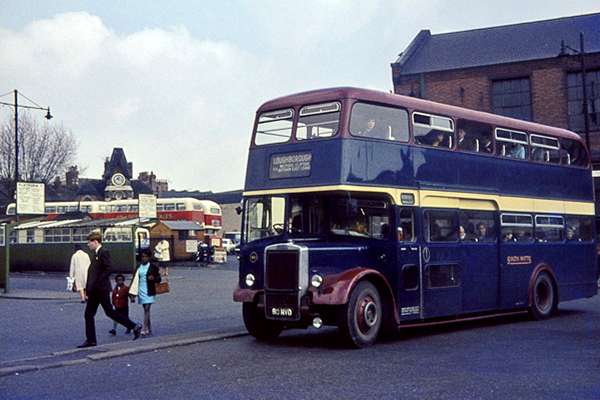
South Notts’ fleet number 80 (80 NVO) was a 1962 PD3 with Northern Counties L65F bodywork, one of two such vehicles acquired just before the Lowlander years. In this shot, taken on 4th May 1968, it is seen leaving platform 4 for Loughborough. Visible in the parking area are three Trent double-deckers, and beyond them the distinctive clock housing of Lammas Lodge (John Stringer)
Platform 4
To my younger eyes this was the best platform on the bus station as it was allocated to independents other than Barton. South Notts Bus Co were the largest user in terms of departures, with their half-hourly route to Loughborough (which saw the frequency as far as Gotham doubled to every 15 minutes on Saturday) operated by a fascinating mixture of lowbridge PD2s and PD3s (two of the latter with front entrances) and low-height Albion Lowlanders. And before anybody points it out, I know that the Lowlanders had “Leyland” lettering on the fibre-glass radiator cowlings – I just prefer to ignore such corporate re-branding. On Wednesdays, Saturdays, and summer Sundays South Notts also had a single-deck presence on their village service to Thrumpton, providing a rare chance to see a Duple Roadmaster which didn’t have Dinky Toys stamped on its base-plate.
The second most frequent user of the platform was Gash of Newark, rightly renowned for its immaculate fleet of Daimler double-deckers. By the time I became a regular at Huntingdon Street the Massey bodied examples reigned supreme, some of them older chassis whose original bodywork by Strachans had disintegrated. Gash’s direct main road service to Newark ran hourly from Sunday to Friday, but half-hourly on Saturdays. A variation which abandoned the main road for Orston and the villages beyond before finding its way to Newark ran infrequently on Wednesdays and Saturdays only, with departures from Huntingdon Street at 1305 and 1505, If you were very lucky this might produce a sighting of one of Gash’s Willowbrook bodied Albion Nimbuses.
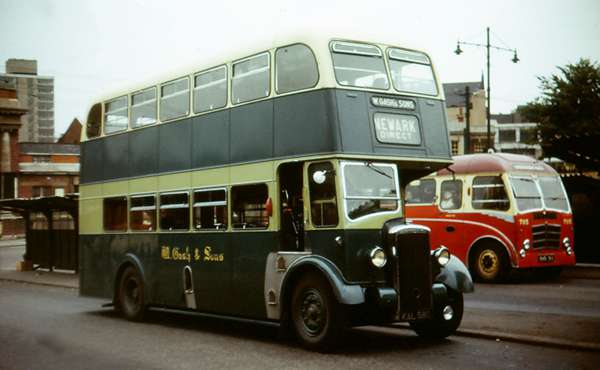
Here we have W Gash & Sons Daimler CVD6 it is on platform 4 and has a Barton BTS1 behind it on platform 3 – presumably on one of the 7/7A/8 cluster although I can’t read its identity or destination.
The third independent to be found on platform 4 was Skills, better known for its long distance tours than its local stage carriage route. As often happens in such cases the route in question was acquired as a by-product of purchasing another operator for its coaching licences. Skills acquired Jacklin’s “Elect Service” of East Bridgford in 1944 along with a half-share of the route from East Bridgford to Nottingham. A year later Trent bought Lewis of East Bridgford which operated the other half of the joint service. Surprisingly, Skills kept their half, operating a succession of new and used double-deckers on the route at a frequency of every 90 minutes, In the 1960s the Skills workings were covered by a pair of forward entrance Met-Cam bodied PD3s bought new in 1959 and looking rather odd in Skills two-tone green colour scheme. Trent operated their share of the service at an intermittent frequency as route number 73, often with open platform rear-loaders which looked very cold and draughty compared to the Skills machines.
Platform 5
Moving on to the northern half of the bus station, platform 5 was the closest to Huntingdon Street and platforms 8 (and later 9) the nearest to the parking area. Before the opening of Mount Street Bus Station platform 5 was the territory of Midland General, providing departure points for services towards Alfreton, Ilkeston, and South Normanton. In post-war years it was allocated to Trent express services, including the X2 to Manchester, X3 to Skegness, X4 to Mablethorpe, X5 to Cleethorpes, X6 to Blackpool via Derby, and X7 to Great Yarmouth. As the destinations suggest, all but the X2 were infrequent seasonal routes, so in the off-peak periods the platform served as a dumping ground for Trent vehicles on layover and was also used as a departure point for tours and excursions.
Platform 6
Barton’s half-hourly service 12 to Leicester was the company’s only contribution to platform 6, but was always worth checking as it offered a variety of single-deckers including the Yeates bodied Reliances and VAL14s. Trent’s service 62 to Mansfield via the direct route was slightly more frequent (every 20 minutes), but offered a more boring offering of PD2s/PD3s/Atlanteans. The platform was Midland General’s last foothold at Huntingdon Street, providing space for the hourly B8 to Mansfield via Hucknall and Rainworth ( a most indirect route compared to the 62) and two much rarer services, the Saturdays only F3 to Mansfield (which omitted Hucknall) and the peak-hour only A1 to Ripley. In my era the B8 and F3 were usually operated by a selection of Lodekka derivatives.
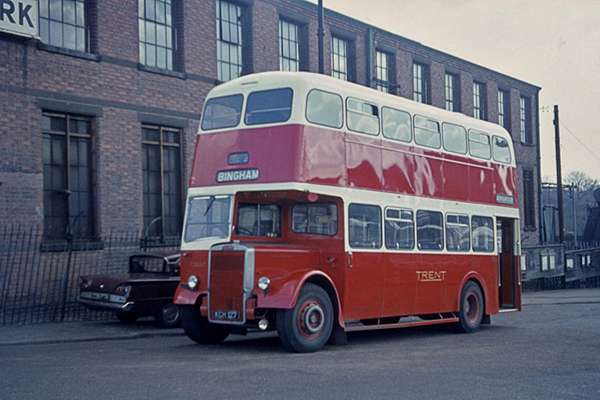
Trent’s 1957 vintage PD2/Met-Cam Orion KCH 127 was given fleet number 1027 when new, but later became fleet number 784 as seen in this 1970 shot. The vehicle is parked next to the Trent inspectors’ hut at the north end of platform 4, preparing for a departure from platform 7 to Bingham on the 79A. (John Stringer)
Platform 7
This platform was used by Trent’s (ex Dutton’s Unity) service 84 to Sutton-in-Ashfield which ran half-hourly on Mondays-Fridays and every 15 minutes on Saturdays. It shared the platform with Trent’s service 79 to Grantham (jointly operated eight times each weekday with Lincolnshire Road Car who showed the service number 33C on their rear entrance Lodekkas), the wholly Trent operated 79A which filled in the gaps to provide a half-hourly service as far as Bingham, and the hourly 63 to Chesterfield (jointly operated by Trent and East Midland, with the latter using service number 12A). The Trent workings provided the usual double-deck fodder, while East Midland provided lowbridge Atlanteans and Lowlanders for variety.
Platform 8
Two further services operated jointly by Trent and East Midland departed from platform 8. These were the Trent 64 (EMMS 36) to Doncaster and the Trent 80 (EMMS 37) to Retford. The 64/36, which took a bottom-numbing 2 hours and 50 minutes to reach its destination, operated every two hours on Sundays-Fridays, but hourly on Saturdays, while the 80/37 was two-hourly throughout the week. On the weekday schedule the two services alternated, but on Saturdays the vehicles operating the two routes left Huntingdon Street in convoy at even hours plus 40 minutes. The two services’ relatively low frequency left plenty of room for other departures, and after the Broad Marsh migration in 1952 the platform became the departure point for “other” express services, meaning those not operated by Barton or Trent. These included Black & White (operating to Cheltenham on behalf of Associated Motorways), Hall Bros of South Shields (with well-known express routes from Coventry to Newcastle via Nottingham), Lincolnshire Road Car (which operated seasonal services to Mablethorpe as route A and to Cleethorpes as route B), Royal Blue (to Northampton and then Bournemouth for Associated Motorways), United Counties (to London), and the Yorkshire Services consortium of EMMS, EYMS, WYRCC, YTC and YWD which came through in force twice each day en route from a huge variety of Yorkshire towns to more southerly termini in Birmingham, London, and Luton.
Until 1961 the platform was also the departure point for Robin Hood’s services to Blackpool, Morecambe, and Southport, and their joint service (with Barton) from Corby in Leicestershire to Glasgow. Barton’s service number for the Glasgow route was 58, and after they acquired Robin Hood the daily (year-round) Blackpool service became the 61, and the seasonal Morecambe/Southport services the 62/63. The operations continued on platform 8 as before.
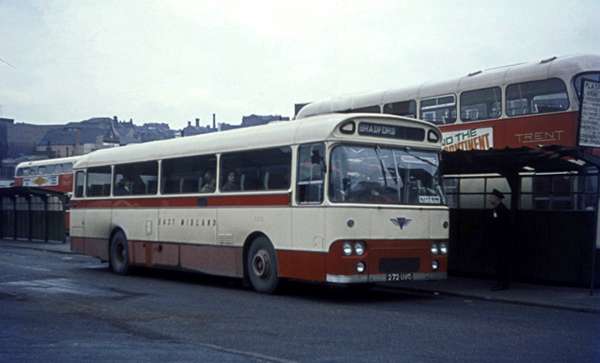
East Midland’s 36ft Reliance/Willowbrook DP fleet number C272 (272 UVO) was new in 1964, and is seen here six years later on platform 8 operating a Yorkshire Services departure to Bradford. (John Stringer)
Platform 9
Although (in theory!) the timings of the Yorkshire Services companies’ twice daily stampedes through Huntingdon Street should have avoided problems with other traffic, experience soon proved that this idea was merely a utopian conceit. United Counties would often have two of their vehicles parked up in the offside lane of platform 8 for extended periods and Hall Bros were equally fond of this as a layover spot for short working duplicates. Then the Yorkshire Services convoy would arrive, only to find the boarding lane blocked by an East Midland double-decker or two as the convoy’s late arrival (due to traffic en route) had placed them into conflict with stage carriage departures. By 1968 enough complaints had been filed with the bus station’s municipal overseers to belatedly stir them into action. The railings between platform 8’s offside lane and the small nose-in car parking area were removed, a shelter erected on the paved area beneath (somehow managing to precisely match the architecture of those erected 20 years earlier on platforms 1-8!) and a sign secured to the lamp-post asserting that this was now platform 9. Basically it was there to provide a “go to” option for express services which could not reach their preferred habitat. At the same time the parking of private vehicles on the bus station (other than a few cars owned by inspectors and other officials) was brought to an end. The practice of mixing car parking with bus manoeuvring areas had never been that wise of a proposition and there had been several accidents over the years, thankfully none of them too serious.
Passing Traffic
Until their all too swift departure in 1966 Nottingham City Transport trolleybuses could be seen at the south end of the bus station, passing the William Booth Memorial Halls on King Edward Street and then either turning right into Bath Street or continuing in a straight line into St Anne’s Well Road. There was also trolleybus overhead wiring on Huntingdon Street, but I never saw it in use and can only presume that it was used by vehicles coming into or out of Parliament Street depot. Apart from the terminating 25/25A the only other corporation motor bus service to use Huntingdon Street was the 51, an irregular service timed to suit the employees of John Player’s tobacco factories on Radford Boulevard. The other end of the route was on Carlton Road, only a few hundred yards beyond NCT’s Parliament Street garage.
After the opening of Broad Marsh in 1952 two new Midland General services found a home there, the F2 to Ilkeston via Kimberley and the F4 to Beauvale Estate. Both of these services bypassed the worst of the city centre traffic by using Huntingdon Street rather than Milton Street, and were usually operated by single-deckers which provided a change from the blue Lodekkas on the bus station itself.
Finally, no account of Huntingdon Street is complete without mention of Hughie’s Cafe, immediately to the north of platform 5. In order to serve as many people as possible in as short a space of time as possible the proprietor had invented his own (more efficient!) way of making tea. Large industrial sized tea-urns were loaded up with tea at such a density that the result was barely fluid. Cups were then placed under the spigot and received an oil-like splash of concentrated tea. The cups were then placed beneath a boiling water heater and the beverage diluted to a more acceptable strength. Yes, it was disgusting, but it was all part of the experience. And Hughie’s prices were very reasonable when compared to those of the far less “colourful” Journeys End cafe in Huntingdon House
Neville Mercer
09/2015
25/09/15 – 09:59
I’d just like to thank Neville Mercer for this 3-Part article. Great reading and appreciable research. I first became imprinted on (initially Barton) buses when a young child in Calverton, so Huntingdon Street bus station has a significant place in my memory.
Stephen Allcroft
25/09/15 – 09:59
Speaking as someone who has lived in Nottingham almost all his life, I’d like to congratulate Neville Mercer on his excellent history of Huntingdon Street bus station. The piece contains a spectacular amount of information and detail, and not confined just to the bus station itself; there’s a fair amount of general history of Nottingham in there as well.
We lived on Clifton Estate, so most of my memories of buses were the services which went to Broad Marsh (the old and new versions). But we sometimes went to Nottingham on the South Notts services to Huntingdon Street, so I could be in the background of those 1960s photos.
KC
26/09/15 – 06:03
Thoroughly enjoyed the series on that wonderful place which came to my attention in the mid 60s, travelling from Yorkshire to visit my Grandad in Chilwell.
The range of vehicles was amazing: two particular memories are awaiting the massive influx of Hall Bros vehicles on their service, and taking years to unravel the Gothic script fleetname and realise that the Newark-based firm was Gash, not Cash! Such are the misconceptions of youth.
And thanks to Neville for at last appraising me of the origins of what I now know to be Lammas Lodge. A building which always fascinated me (but not as much as the Barton vehicles parked near it).
John Carr
27/09/15 – 05:51
Re the South Notts PD3, though the lower deck window layout is a little odd due to the position of the door, I just wonder how many 30 ft double deckers were built with four bay bodies?
Phil Blinkhorn
02/10/15 – 05:56
Neville Mercer, I applaud you for this article. Thank you.
Like many other people, I find these have tidied up/triggered off long dormant memories, may I add a few of my own:
The Grantham service, which was in my recollection, the only Lincolnshire service to reach Nottingham – how come the “33C” route number – what were routes 33, 33A and 33B?
In this context, someone recently tried to explain that suffix
A meant Any deviation from the main route
B meant terminates Before normal destination
C means Continues beyond normal destination
D means any other Deviation from normal route
Please let this start off another series of theories?
Changing the subject, I never twigged that South Notts 76 & 80 (Northern Counties bodied PD3s) were four-bay 30-footers. I suppose they were really more like four-and-a-bit since the upstairs front and back bays were rather long, resulting in the extra bit in front of the entrance doors.
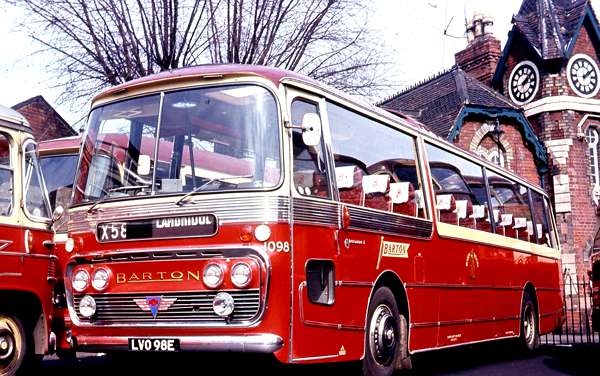
I have enclosed a slide from the late 60s – I suspect the background includes “Lammas Lodge” am I right?
Rob Hancock
03/10/15 – 04:00
This series is absolutely brilliant. I lived in Nottingham or not far from it throughout the 50s, and can remember Huntingdon Street occupied by buses of every hue. Trent predominated, and seemed to be mainly pre-war Regents rebodied by Willowbrook – also I think a few utilities(?) and COG5s. At that time, Trent Leylands only seemed to figure on the No.8 from Derby, which came into Mount Street. Barton was still using a mixture of the famous Duple PD1s and PS1s, second hand PD1s from Leicester (and elsewhere!), and ex-Leeds Roe-bodied Regents and TDs. Midland General hadn’t yet received Lodekkas, and the height restricted route B8 was usually operated by lowbridge Regents of the RLH type. I can recall a trip to Sherwood Forest (Edwinstowe) on the East Midland 36 with a Guy Arab in the old sand-coloured livery. NCT’s 25, 25A and 25B were actually not all that frequent – only about half-hourly at that time, and often still run with the 1938 Met-Cam Regents – later superceded by the very similar 1948/49 batch, followed by the OTV Park Royal series. Interesting question about the Lincolnshire 33C – which again, I remember using about 1952, at which time we had a Bristol K going, and something different (a Leyland?) coming back. I am not certain, but I have a feeling the 33 may have run from Grantham to Bottesford – which would agree with the theory about “extension beyond normal destination” – but I had never heard the idea before. Just a small observation, the NCT 51 was never timetabled to start at Huntingdon Street – though I may have “loitered with intent” before proceeding to its starting point at the junction of Alfred Street South and Carlton Road, about two minutes run away.
Stephen Ford
05/10/15 – 07:10
Many thanks to all who have posted for their kind words. Perhaps I could respond briefly to a couple of the posts.
Yes, Rob, that’s Lammas Lodge and you can tell that the photo is taken after 1967 as that was the year in which Barton started using “X” prefixes for its express services. I should say officially, as crews on the 61 to Blackpool were given to displaying “X61” after acquiring the service from Robin Hood six years earlier – presumably as it mimicked the “X60” at the northern end of the route. Speaking of Lammas Lodge, I failed to discover any evidence whatsoever that it was once used as a police station as alleged in a couple of publications which show it in the background of photographs. As far as I can tell it was a park-keepers’ lodge at first, and then when no longer needed for that purpose (as the former park had disappeared beneath the bus station) it was rented out to private tenants. A retired military officer was the tenant in the late 1930s, and then by 1950 the tenant was the widow of a local professional boxer. One website refers to it as “St Michael’s Police Lodge”, but this is clearly wrong. The part of the future Huntingdon St where it was located was originally Millstone Lane. St Michaels Road started three blocks to the north of the site. Also, the only reference I can find on the Web apart from that local nostalgia site, is to a Masonic “St Michaels Police Lodge” in suburban London. Does anybody know any differently from authoritative sources (ie, not just repetitions on different sites of the original assertions?)
Moving on to the NCT route 51, I never actually said that it started at the bus station, but that it passed along Huntingdon Street between the terminal points as named. Perhaps I could have put it more clearly but by that stage deadlines were looming!
Once again, thanks to everybody, particularly to Stephen for the 1950s reminiscences.
Neville Mercer
06/10/15 – 07:01
Well, you live and learn! I had never realised that the NCT 51 ever went along Huntingdon Street (except the very north end, far beyond the bus station). Its traditional route was to head straight up Alfred Street (south, central and north) turning right onto Huntingdon Street just short of where it merges into Mansfield Road. The evidence was on my bookshelves in the 1971 timetable. Following the demolition and re-development of the St Anns area, Alfred Street ceased to be a through road. Thereafter the 51 started along Alfred Street south, then left onto St Anns Well Road, past the bus station, and left again (southwards) down Huntingdon Street, right into Lower Parliament Street, right into Glasshouse Street (back of where the Victoria station used to be) and left, back into Huntingdon Street (now heading north) just above the bus station – a long way round to go nowhere, no doubt caused by one way traffic restrictions.
Stephen Ford
30/10/15 – 06:33
Neville,
An interesting series of articles, thank you.
Nottingham City Transport service 19 started operation from Huntingdon Street to Lenton Abbey Estate from 24/11/29. From 28/11/37 it was extended to Gordon Road/Dowson Street (the area known as Bluebell Hill) still operating via Huntingdon Street bus station. From February 1939 it was further extended to Porchester Road/Haywood Road, before being curtailed to St. Ann’s Hospital from July 1939. Service 19 was altered to run between the Old Market Square and Lenton Abbey Estate from 06/05/45.
Service 25 started operation from Huntingdon Street from 15/11/31. All journeys, whether via Carlton Road or Mansfield Road operated as service 25, the a suffix for Mansfield Road journeys was not used until 1944.During the 1960s journeys outwards via Carlton Road operated as service 25 and retained this number when returning inwards via Mansfield Road to Huntingdon Street. Journeys outwards via Mansfield Road operated as service 25a and retained this number when returning inwards via Carlton Road to Huntingdon Street. Short workings to Westdale Lane Top via Carlton Road used service number 25b were introduced from 12/04/53.During the 1960s the service frequency was better than the 30 minute headway suggested by Stephen . Although this headway applied on Sundays the off peak frequency (all via Carlton Road) was every 20 minutes, with a combined ten minute peak service via Carlton Road operated by service 25/25b and every 20 minutes via Mansfield Road. Services 25/25a/25b moved to Queen Street in the city centre from March 1972.
Barton’s service 14 to Ruddington operated from Broad Marsh not Huntingdon Street. It was the 54 to Clifton via Ruddington that operated from Huntingdon Street. Barton’s service 12 to Leicester also called at Broad Marsh on the way to and from Leicester.
The new Broad Marsh bus station opened on 31/10/71 and South Notts and Gash transferred their Loughborough and Newark services to Broad Marsh from Huntingdon Street from that date.
I can’t think why NCT service 51 figures in the discussions as during the 1960s it operated via Alfred Street south, central and north and only used the short section of Huntingdon Street between Alfred Street north and Mansfield Road, which was some distance from Huntingdon Street bus station.
There was a third catering facility at Huntingdon Street in addition to Hughie’s Cafe and Journey’s End. This was not available to the general public as it was Trent’s staff canteen located behind the Trent booking office and was available to all bus crews using the bus station.
Michael Elliott
30/01/16 – 18:42
To Neville,
Thanks for the enthralling series. As one who does not know Nottingham at all, how much if anything is left of the area ?
I am not of course expecting any of the wonderful vehicles to be seen but if an opportunity arose to visit Nottingham are there any of the buildings still extant or has modernisation totally wiped the area clean of all traces.
Thanks for any information.
Mike Norris
Leave a Reply